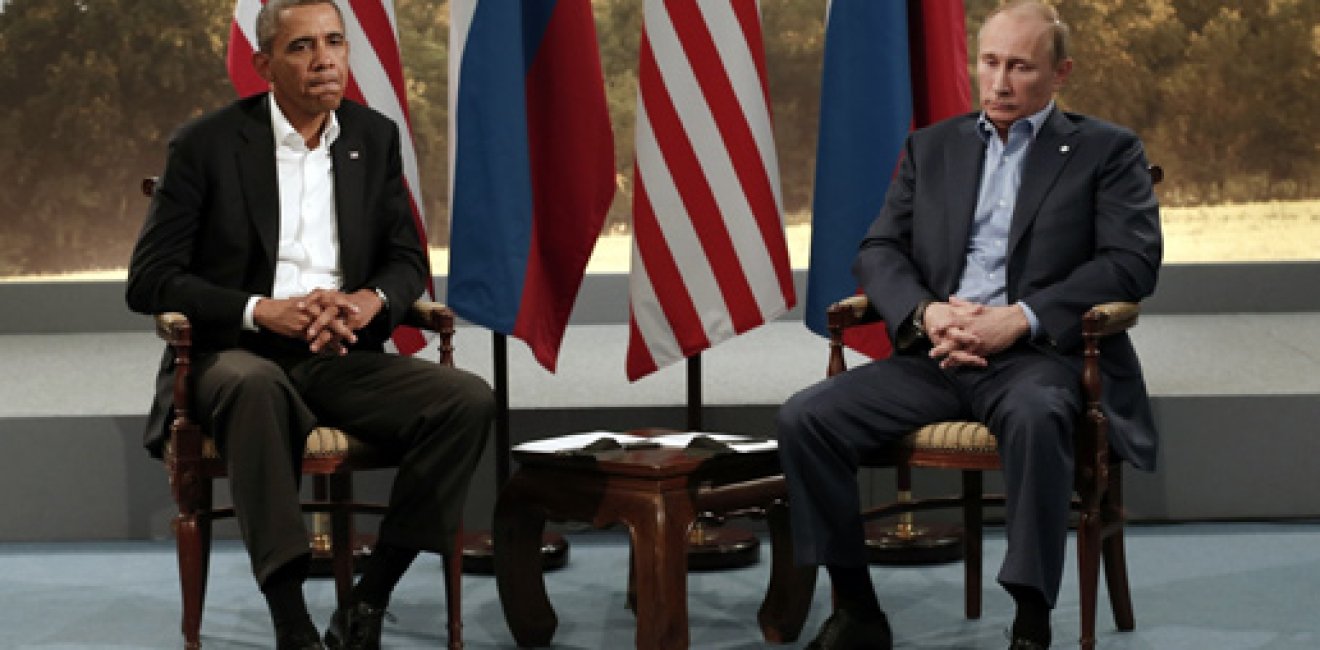
A blog of the Kennan Institute
To receive an email when a new post becomes available, please subscribe here.
The war raging in Syria involves not just numerous fighting sides, both state and non-state, but also rival political strategies. The foreign policies of Moscow and Washington had been headed for collision for quite a while, and they finally met in Syria. The clash between them is proving fateful for the region and for all the players involved.
Since its surprise move into Syria in late September, the Kremlin has succeeded in both preventing the demise of Bashar al-Assad and disrupting the Western game in the Middle East. Whether by design or by necessity, the outcomes the Kremlin has been so far able to achieve in Syria are similar to those achieved in Ukraine. Over the weekend, Strobe Talbott, the president of the Brookings Institution, described the situation as another of “Putin’s gambits” – a “quasi-ceasefire, a de facto partition, and a Russian zone of influence.”
Putin has won in Syria, New York Times columnist Roger Cohen declared in a commentary published last week. “It is President Vladimir Putin and Russia who are ‘making the weather’ in Syria absent any corresponding commitment or articulable policy from President Obama,” Cohen said. “This isn’t the Russian ‘quagmire’ Mr. Obama predicted last year when Moscow stepped into Syria,” states an editorial in The Wall Street Journal titled “Putin’s Syria Victory.” “Mr. Putin has consolidated his strategic position in the eastern Mediterranean with a tough but limited military intervention… Next month’s negotiations can then ‘freeze’ the conflict in place, a tactic Russia used to its advantage after the invasion of Georgia in 2008 and last year’s Minsk agreement over eastern Ukraine.”
American commentators may think that their country’s foreign policy is nothing to boast about. But a supposedly victorious Russia has nothing to boast about either.
European governments now seem to be resigned to a lack of American assertiveness. “We seem to be disappearing from their calculations,” said the historian Walter Russell Mead in an interview with Bloomberg View on the sidelines of the Munich Security Conference. “From the European standpoint, Putin has become somebody that, like it or not, they have to deal with.”
Of course, the political campaigning that is picking up momentum in the U.S. does add anguish to the debates about the current administration’s policies. Still, none of the comments quoted are entirely off the mark. All the more interesting, then, is the fact that there is no corresponding triumphalism at the Russian end of the divide.
American commentators may think that their country’s foreign policy is nothing to boast about. But a supposedly victorious Russia has nothing to boast about either. None of the Russian officials would brag that Moscow’s foreign policy objectives include chipping bits off other countries’ territory, staging quasi-ceasefires, or creating frozen conflicts and economic black holes. The list of extralegal zones created by Russia is indeed long, but Russia cannot, and will not, openly recognize this as a policy.
Russian officials and commentators close to the Kremlin see themselves as pressured and misunderstood, rather than victorious and triumphant. “Almost every day we are accused of making new horrible threats either against NATO as a whole, against Europe, or against the U.S. or other countries,” Prime-Minister Dmitry Medvedev said in his remarks at the Munich Security Conference. “The world has slid into a new period of Cold War.”
What many in the West see as successful, if aggressive, foreign policy, Moscow apparently sees as its external line of defense against Western mischief and attempts at regime change in Russia. What many in the West see as a deliberate strategy of producing black holes may very well be a result of the Kremlin’s desperate attempts to defend its political system from perceived challenges.
On Saturday, President Obama held a call with President Putin to try and talk Moscow out of continuing its airstrikes against “moderate opposition forces” in Syria. This, according to the White House, will help in the negotiations of a truce. But from Moscow’s perspective, it will not: it is the use of force that drives the negotiation process in a direction favored by the Kremlin. Russia has become reliant on the use of force to change facts on the ground in order to strengthen its negotiating position.
The Kremlin’s foreign policy tool kit is severely limited. Moscow has made some half-hearted attempts at projecting soft power, but it has never been strategic or credible at it. After the annexation of Crimea and a number of other unilateral moves, the level of trust between Moscow and the West is as low as it might have been at the height of the “first” Cold War.
What many in the West see as successful, if aggressive, foreign policy, Moscow apparently sees as its external line of defense against Western mischief and attempts at regime change in Russia.
Absent mutual trust or credibility, the Kremlin prefers conflicts around Russia to keep simmering. Being able to turn the heat on and off is one of the few credible foreign policy levers Moscow still has. But the price for constantly relying on this crude tool is Russian society’s continued disassociation from its neighbors — Georgia, Ukraine, Kazakhstan, even Belarus. By the same token, Moscow has now succeeded in making formidable enemies among the Sunni powers, especially Saudi Arabia and Turkey. It is worth keeping in mind that the Syrian situation is very different from the Ukrainian one. Turkey is as involved in Syria as Russia is involved in Ukraine.
The foreign policies of Moscow and Washington are expressions of two very different political narratives. Putin’s foreign policy was prepared by years of perceived humiliation and Western encirclement. One domestic reform Moscow has been very particular about is the reform of the military. It has partially succeeded and the Kremlin is eager to prove to the world that “Russia is back.” Everything else is secondary, and the Russian society seems to agree.
The U.S. situation is almost exactly opposite. Obama’s foreign policy was prepared by years of perceived overextension of resources to foreign causes, to an endless involvement with Afghanistan, to a “three-trillion-dollar war” in Iraq. The whole point of the current White House’s don’t-do-stupid-stuff and lead-from-behind approaches was to gradually exit the conflicts and concentrate on domestic issues.
Russia and the U.S. have been moving in opposite directions politically and even economically. Both sides have been talking past each other and acting at cross purposes. We will attempt, in the next post, to look at the avenues of bridge building.
The opinions expressed here are solely those of the author.
Author

Editor-at-Large, Meduza

Kennan Institute
After more than 50 years as a vital part of the Wilson Center legacy, the Kennan Institute has become an independent think tank. You can find the current website for the Kennan Institute at kennaninstitute.org. Please look for future announcements about partnership activities between the Wilson Center and the Kennan Institute at Wilson Center Press Room. The Kennan Institute is the premier US center for advanced research on Eurasia and the oldest and largest regional program at the Woodrow Wilson International Center for Scholars. The Kennan Institute is committed to improving American understanding of Russia, Ukraine, Central Asia, the South Caucasus, and the surrounding region through research and exchange. Read more

Explore More in The Russia File
Browse The Russia File
Chechnya as a Model of Modern Russia

Russia’s Indigenous Communities and the War in Ukraine

Gas and Power in a Changing US–Russia Relationship

